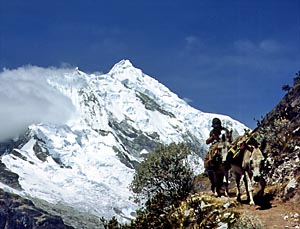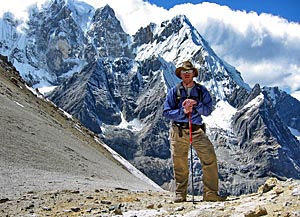For residents of Peru's remote villages high in the Andes mountains, climate change is right outside the back door.
"Most of these people have lived beneath these glaciers their entire lives," said geographer Jeffrey Bury, an assistant professor of environmental studies at UCSC. "They can point to where the glacier was when they were children, and now the ice is disappearing. They've watched it move their entire lives."
As the world's highest and most glaciated tropical mountain range, the central Andes have the unfortunate distinction of being at the forefront of global warming. In Peru, residents are already coping with unpredictable seasons and weather extremes that make it hard to know when to plant their crops and graze their animals, said Bury.
"Tropical glaciers are very near the equator at elevations up to 20,000 feet," said Bury. "If you look at Mount Kilimanjaro in Tanzania, the ice cap is almost gone."
This summer, Bury and graduate student Adam French will spend eight weeks in the central Peruvian Andes, known as the Cordillera Blanca or "white corridor," as part of an interdisciplinary team of scholars investigating glacial recession. Bury's team will interview residents of several remote mountain communities to understand how changes in water availability are affecting their livelihoods, while colleagues from the Byrd Polar Center at Ohio State University and McGill University will evaluate glacial volume and hydrological fluctuations.
"Scientists have documented glacial recession in the central Andes since the early 1900s, but glaciers are melting faster than anyone anticipated," said Bury. "Many glaciers are almost gone, and water levels in the valleys below are changing. We're seeing very clear impacts in the region that are likely to foster more intense social conflicts downstream."
Water rationing is already in effect in Lima, home to 8 million Peruvians, and Bury expects the impacts of climate change to intensify, in part because the entire western shelf of Latin America is a desert that has been transformed by vast irrigation networks and hydroelectric projects. As the glaciers disappear and water becomes less plentiful, disputes over water ownership and use are inevitable, he predicted.
For residents of remote mountain villages, glacial melt provides water for consumption, livestock, and sanitation. As the glaciers disappear, residents are being forced to adapt, he said. "People are really noticing this in their lives already," said Bury, who speaks fluent Spanish. "They have enough to drink, but it's affecting agriculture, grazing, lake levels, and fish in the river. They're concerned." Weather extremes related to climate change, including unseasonable hail storms, sudden freezes, and dry spells that destroy crops, make people quite vulnerable, he added.
Bury has worked in Peru for more than a decade, including several years spent evaluating the impacts of new mining operations, ecotourism, and conservation efforts in the remote Cordillera Huayhuash (pronounced "why-wash"). This summer, Bury and French will concentrate their time in three small communities near the regional capital of Huaraz. Part of separate watersheds, each village is home to several hundred people who live on the border of the ice. Bury's goal is to interview residents of 75 households over the next two years, building on preliminary work his team began last summer.
"We know a lot about the ice and snow," said Bury. "But we know a lot less about how human populations are going to respond to these changes--or are already responding. It's a really challenging conversation, because the adaptations are very political and overlain by historical inequalities."
Working at elevations above 10,000 feet adds a host of challenges, including what Bury calls "four seasons every day."
"We each wear about four layers, because in the high mountains, you get bitter cold in the morning, it's super hot mid-day, and then it's cold again at night," said Bury, an avid alpinist who jokes that he's "getting a little old for this."
"It can be taxing for everyone, including me," said Bury. "As close as we are to the equator, the sun is about as strong as it gets. I sometimes wear zinc oxide over my entire face."
With funding from the UCSC Committee on Teaching, Bury will record some of his team's field work this summer and produce "micromodules" for classroom use next fall. "It's part of bringing the field to the classroom, so we'll wear wireless microphones and will record in situ video lectures that will make the work accessible to more undergraduates," said Bury, a self-described technology buff.
But the work itself is "terribly important," said Bury, who is collaborating with fellow project leader Bryan Mark of Ohio State University (OSU), a geographer affiliated with OSU's Byrd Polar Research Center. With funding from the National Science Foundation and NASA, they also work closely with earth scientist Jeffrey McKenzie of McGill University, The Mountain Institute, and the American Alpine Club.
"We need this data to get a better sense of what's going on in the central Andes," said Bury. "It's very important for the people of the region and for our scientific understanding of what's happening. It also matters for the undergraduates and graduates we'll be training. I've always said the best thing an undergraduate could ever do is leave the country for a while. For those who can't manage that, we're going to bring a piece of this remote part of the world back to the classroom."
Ultimately, Bury plans to share his findings with Andean residents and with the Peruvian government to help generate policy solutions that will help Peruvians navigate the rapidly worsening impacts of climate change.




